Menu
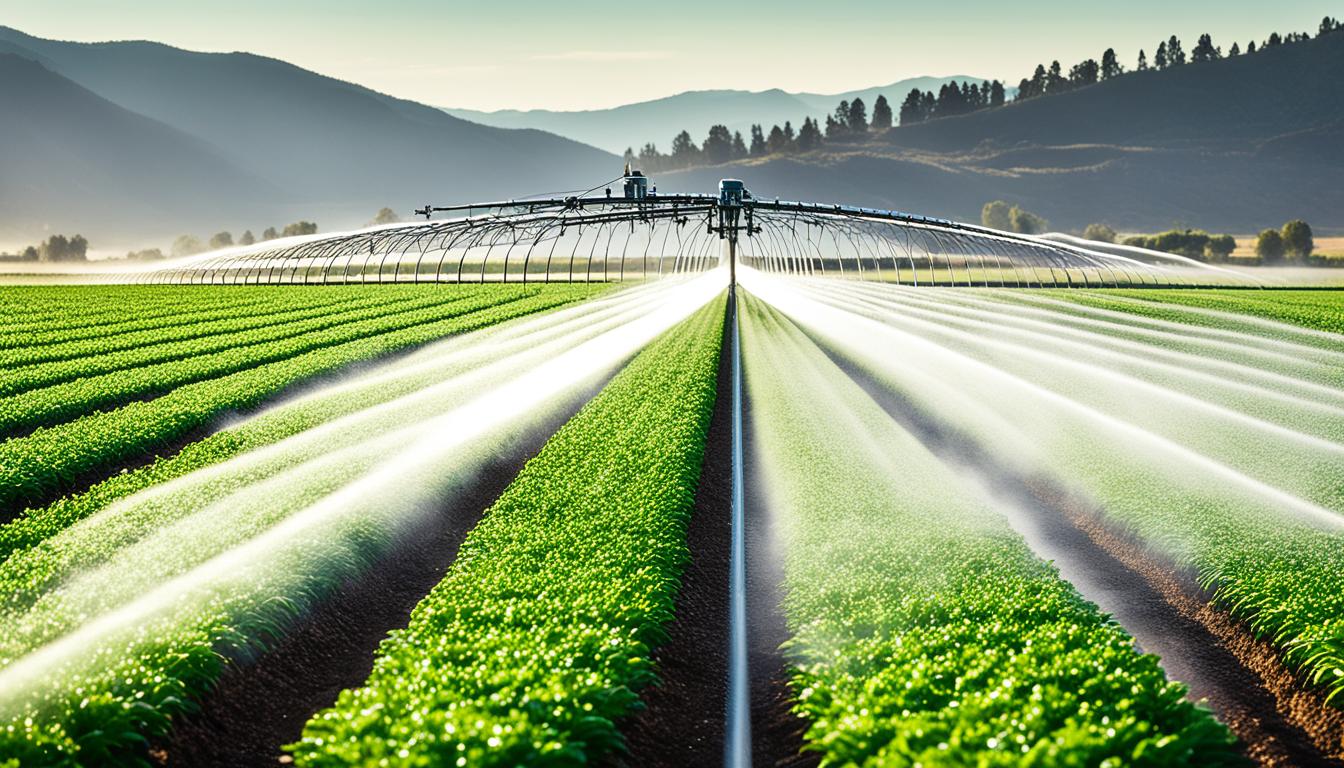
Did you know precision irrigation increases crop yield by 8%? A study with 55 farmers by the U.S. Department of Agriculture found this. It shows how powerful precision irrigation is in managing water for agriculture. It brings better crop yields, saves water, and cuts down on chemical use.
Precision irrigation is a high-tech way to water plants. It gives them the exact amount they need directly. This method is important now more than ever. With more people to feed, global climate change, and less water available, it’s a game-changer.
It lets farmers control water and nutrients carefully. This not only saves work but also keeps the soil healthy and prevents water waste. So, farms use less resources but make bigger and better crops.
Precision irrigation means watering crops in the right way. It helps crops grow better by using water and nutrients carefully. This method relies on smart watering systems. These systems give plants the right amount of nutrients when they need them.
Precision irrigation is all about using water and fertilisers effectively for better crops. It uses advanced watering methods to reduce waste. This allows for almost all of the water to be used by the plants.
Compared to other irrigation types, precision irrigation is much more efficient. For example, pivot irrigation is around 80-85% efficient, while furrow irrigation is only about 60% efficient. With smart watering systems, farmers improve their profits quickly.
Irrigation has changed a lot over time. It used to rely heavily on people working to water the fields. This method was not very efficient and wasted a lot of water.
But now, precision irrigation has taken over. It uses modern technology like pressure-compensated emitters. These help spread water evenly on the crops. It works well on all kinds of land and in any soil.
Today, precision irrigation is becoming even more advanced. New technologies are improving how water is used on crops. Fine control over water droplets and pressure means each plant gets just the right amount of water.
There are also systems where the water goes under the ground to the roots. This cuts down on water lost to the air. It’s perfect for areas where the soil doesn’t hold water well.
Now, smart sensors and automatic watering based on the weather are being used. This helps farmers know exactly when to water. These new tools are changing farming for the better. They let farmers use land, water, and fertilisers the best way possible for great harvests every season.
Recent advancements in technology have changed how farmers water their crops. It’s made sure that water is used carefully and efficiently. Thanks to IoT, smart sensors, automated systems, and data analytics, farming is now smarter than ever.
IoT has changed how we manage water on farms by using smart sensors. These sensors, like Farm21 sensors, check the moisture in the soil at different levels. This lets farmers know exactly when and how much to water their crops.
Automation makes sure the right amount of water gets to the right places, quickly. It’s especially useful with systems like precision mobile drip irrigation, which makes sure water goes exactly where needed. This tech also uses weather forecasts to water at the best times, which is great for the crops.
Farming using data analysis helps farmers water their fields in the best way. This includes using tools to spot when crops need more water. With satellite images and weather data, farmers can water their fields just when needed. This can boost crop growth by as much as 8%.
Using IoT, advanced irrigation, and data can save money and water. It makes farming more precise and cuts down on wasted resources. Overall, these technologies help farmers worldwide grow more with less.
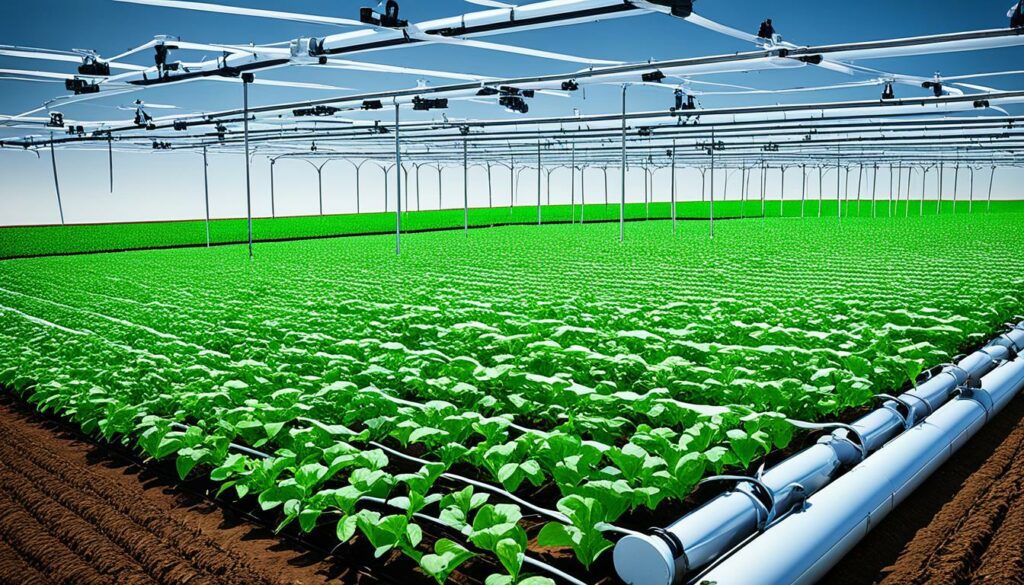
Precision irrigation offers many benefits. It uses water-saving methods to save resources. It also boosts farm productivity with smart farming techniques. Let’s see how it helps in farming.
Precision irrigation is highly efficient, saving up to 95% of water. This is much better than traditional methods. It uses accurate measurements and applies water precisely to save water. Technologies like pressure-compensated emitters and filtration systems help. They make sure water reaches where it’s needed without waste.
Precision irrigation can increase crop yields by up to 8%. The U.S. Department of Agriculture confirmed this. It gives plants the perfect amount of water and nutrients they need. This makes crops grow better. For example, subsurface drip irrigation keeps roots moist, which is great in dry soils. It also cuts down on wasted nutrients, improving plant quality.
Precision irrigation reduces the work farmers need to do. This is thanks to automatic systems. These systems let farmers focus on more important jobs. For instance, the Farm21 sensor adjusts water levels by itself, based on the soil’s moisture. This cuts down on manual work. It saves money and makes farming smarter.
| Type of Irrigation | Water Use Efficiency | Crop Yield Increase |
|---|---|---|
| Precision Irrigation | 95% | 8% |
| Pivot Irrigation | 80-85% | Not specified |
| Furrow Irrigation | 60% | Not specified |
Precision irrigation does a lot for farming. It saves water, increases crops, and cuts labour costs. These benefits show how the tech improves farming. It makes farming smarter, more sustainable, and profitable.
Precision sprinkler irrigation systems play a key role in efficient watering and promoting healthy plant growth. They ensure water is distributed evenly, meeting various crop and field needs. We will explore different types of sprinkler systems and their benefits for plant growth, efficiency, and how they enable fertigation.
There are many types of sprinkler systems for different farming needs. For large areas, central pivot systems are great because they cover a lot with little work. For fields shaped like rectangles, linear move systems are flexible. Portable systems work well for smaller spaces and rough ground. All these systems can use different nozzles and adjust the water flow to suit each plant’s needs.
Precision sprinkler systems are very efficient, up to 95%, using water well. This is much better than pivot systems which use 80-85% and furrow systems at 60%. They work by spreading water evenly over the soil, which is great for different types of land. These systems also help save water, cutting down use by up to 25% compared to usual methods.
Fertigation is when fertilisers are put into the water for plants. Precision systems are perfect for this. They make sure the right amount of nutrients goes to each plant. This boosts plant growth and waste less, helping the environment. Using these systems can pay off in less than three years, saving money and being good for the Earth.
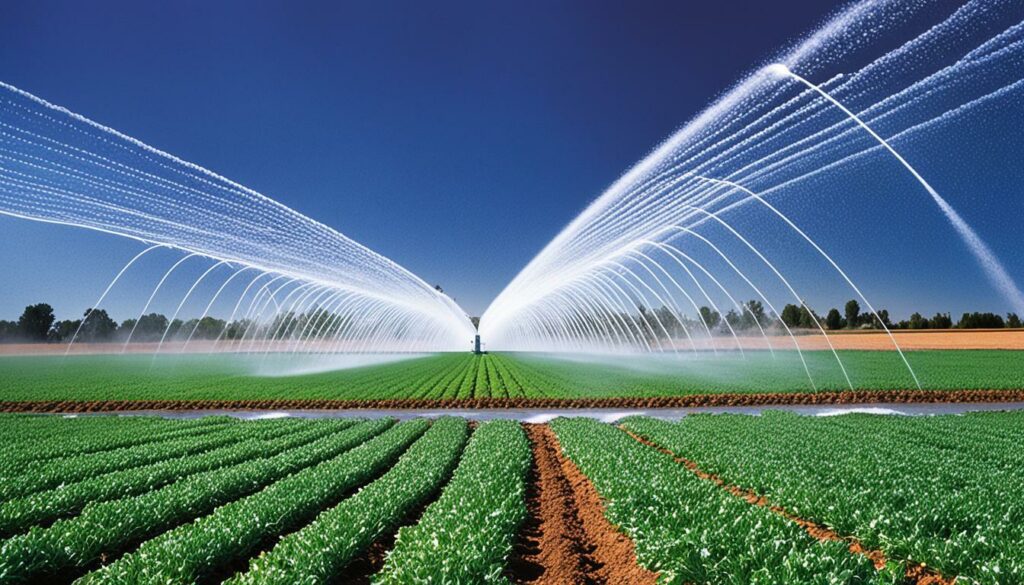
| System Type | Water Use Efficiency | Coverage Area |
|---|---|---|
| Centre Pivot | 80-85% | Large Fields |
| Linear Move | 85% | Rectangular Fields |
| Portable Sprinkler | 90% | Small Plots |
| Precision Sprinklers | 95% | Variable |
Drip and trickle irrigation systems are smart ways to water plants directly at their roots. They are better than old ways in many ways. These systems use special irrigation components like drip lines. Also, they have emitters and valves to control the water flow well.
The key irrigation components in drip irrigation include:
Drip and trickle systems work by giving water at low pressure. This cuts down water loss and keeps nutrients in the soil. That means better plant growth.
They also stop weeds growing around plants by keeping those areas dry.
The trickle irrigation benefits are many. They help plants grow better while using less water. Water is put right where it’s needed, so plants don’t have to fight weeds for it.
This way of farm watering is very efficient and works on many farms. It helps make farming friendlier to the environment.
But, drip systems do have some problems. They can get blocked by small things in the water. Machines or plant roots can also damage them. So, they need looking after to work well.
Subsurface drip irrigation is an advanced way of farming that uses less water. It can boost crop growth without wasting water. Water is sent right to the roots of plants underground. This method cuts down on water loss from evaporation and runoff.
It’s particularly good in dry places where saving water is crucial. Unlike sprinklers that lose up to 45% of water to the air, this method stops that loss. It makes sure plants get all the water they need straight at their roots.
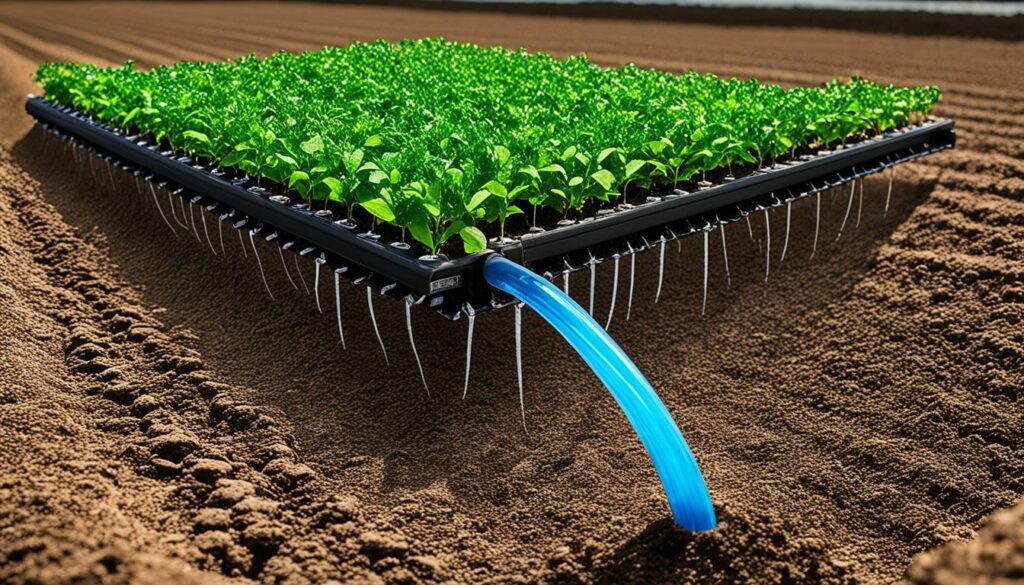
These systems can work well for over 20 years if looked after properly. For example, the Rivulis T-Tape can be nearly 690 meters long. This length is great for big fields or areas on a slope. It shows how these systems help save water and last a long time.
Adding smart sensors like Manna by Rivulis can make them work even better. With these sensors, farmers can watch the water and nutrients plants get, from anywhere. This means less work for people, but the right care for the crops.
Tests have shown that this method can cut water use by three to five times compared to sprinklers. A test at the Club at Las Campanas in Santa Fe proved this. The grass was as healthy as with sprinklers but used much less water. This shows how useful subsurface irrigation can be outside of farming too.
But, it’s important to set up and look after these systems properly to avoid problems. Using drip lines that don’t clog and cleaning the system often can keep it working well. This is key to making sure the system lasts and works without trouble every season.
In the end, subsurface drip irrigation is a game-changer for farming. It helps use water better, supports growing healthy crops, and cares for the environment. It’s a smart choice for the future of farming.
Soil moisture sensors are at the heart of precise irrigation today. They measure the soil’s water content. This data helps farmers water their crops better, saving water and boosting plant growth.
Many soil moisture sensors exist, from simple to complex, fitting different needs and costs:
| Type of Sensor | Cost per Sensor | Additional Costs |
|---|---|---|
| Neutron Probe | $10,000 | Access Tubes: $25 – $30 each |
| Tensiometers | $80 | Transducers: $140 – $155 each |
| Granular Matrix Sensors | $40 – $50 | Handheld Meters: $250, Data Loggers: $500 |
| Capacitance or FDR Sensors | $40 – $350 | — |
Neutron probes, tensiometers, and granular matrix sensors help control water usage. They react quickly to soil demands. This leads to better crop growth, using less water. Studies, like one by Mittelbach et al., prove how effective this method is.
These sensors collect vital farming data. Data loggers, ranging from $500 to $3,500, keep this data for future use. When combined with weather updates and crop history, farmers boost their watering strategies.
With tools like granular matrix sensors, neutron probes, and tensiometers, farmers save water. Adapting to field conditions avoids crop stress. This, in turn, helps produce more with less water. The result is seen in better harvests and lower water use.
Precision irrigation has greatly boosted farming efficiency in many places. For instance, leaders like Netafim, CropX Technologies, and Arable Labs have shown significant progress.

Netafim has sparked a water-efficient farming revolution with drip systems. A farm increased milk production by 70% in four years using these methods. Pasture growth also shot up by 43%, and they cut fertiliser costs by 57%.
This success mainly comes from better control over how nutrients are delivered.
CropX Technologies give farmers the power of advanced soil analytics. This allows farms to predict production within 2 to 3% of actual figures. Such close forecasts save money on fertilisers, showing how smart irrigation choices can boost profits and help the planet.
Arable Labs uses top-notch IoT sensors to help farmers gather vital field data. This system gives actionable insights, leading to major water use improvements. For example, their monitoring saved 45% on base fertilisers, proving the financial perks of precise irrigation.
Together, case studies on Netafim, CropX, and Arable Labs show how technology is reshaping agriculture. They make farming more sustainable and profitable.
Remote irrigation management is a big step in *smart agricultural technology*. It lets farmers watch over their fields from anywhere using a smart device. This boosts *farming mobility*. These systems make it easy to change settings in real time, manage many farms, and cut down on trips to the site.
Lindsay Corporation offers a solution for remote irrigation management. Their FieldNET tech gives you tips every day, no matter your irrigation equipment brand. With FieldNET and WaterTrend, you can see a 7-day water trend for your crops, helping you plan better.
Zimmatic dealers also provide support by finding the best irrigation for you. They use NMC Air software, which lets you monitor and operate your irrigation controllers online in real time. This setup mixes with web and mobile connections for simple, quick control.
Remote irrigation management brings many perks. You can get alerts on your mobile or computer when there’s a problem, letting you fix things fast. This method ensures you use water and nutrients wisely.
The EQIP helps farmers save water, prevent soil erosion, and improve soil health. Also, FieldNET allows farmers to schedule watering remotely, which increases water efficiency. This saves money and helps the environment.
The NMC Air Kit, which has a gateway, communication card, clod license, and casing, helps make full remote control possible. It means you can manage everything without being on the farm, boosting how well you work and increasing your productivity.
| Feature | Benefit |
|---|---|
| FieldNET with WaterTrend | 7-day water trend for field-specific needs |
| NMC Air Software | Real-time in-field operation and traceability |
| EQIP | Financial and technical assistance |
| Remote Telemetry Scheduling | Maximise water efficiency |
| Zimmatic Dealers | Optimal irrigation solutions for profitability |
Data analytics is key in precision irrigation, giving us insights that improve farming decisions. It gathers information from many devices like sensors, drones, and GPS, showing us the condition of the land and plants. This data helps us manage and use water better, changing how we farm.
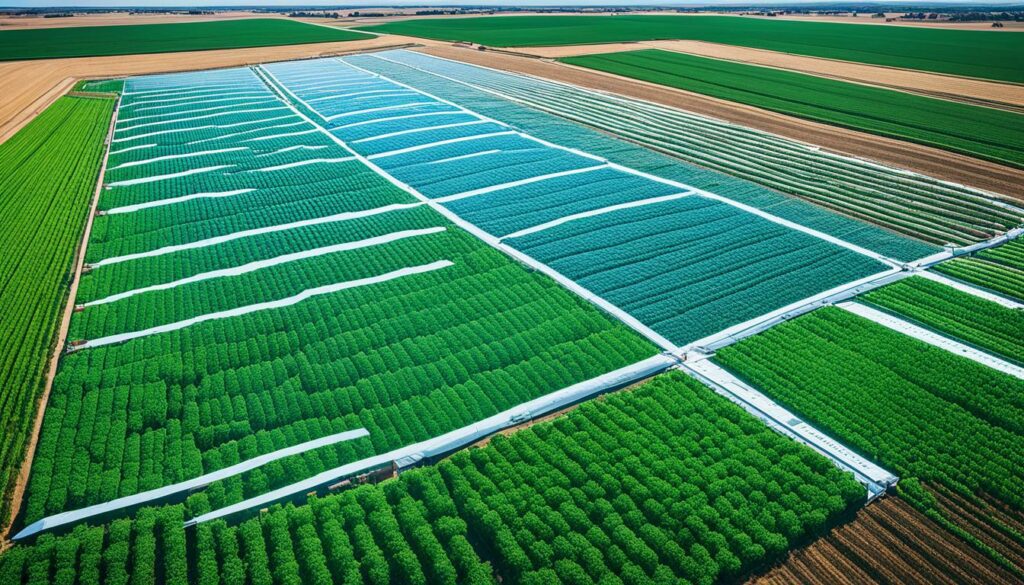
Farms now use many tech tools to collect data. Things like soil moisture sensors and drones are common. The information they collect lets farmers understand their fields better. Around half of US farms use special software because technology is important in farming today.
The magic of precision irrigation is how well it understands sensor information. With smart technology and algorithms, it turns data into useful advice. For example, studying soil and moisture helps create maps. These maps guide when and how much water and nutrients crops need.
Data analytics makes watering more efficient. It uses weather, soil, and crop data to decide when to water. This fine-tunes irrigation, saving water and boosting crops. Tools like the Climate Corporation’s FieldView show how technology can help farming. It aligns with global aims to grow more food for a larger population by 2050.
Check out the table below to see how data and analytics improve when to water crops:
| Data Source | Type of Data | Contribution to Irrigation Optimisation |
|---|---|---|
| Sensors | Soil moisture, pH, nutrient levels | Fine-tuning watering needs |
| Drones | Aerial imagery | Monitoring crop health |
| Satellites | Wide-scale field monitoring | Providing comprehensive field data |
| GPS | Positioning data | Precise application of water and fertilisers |
Precision irrigation is vital in reducing the environmental impact of farming. It gives crops the exact water they need, cutting down on waste. This method helps make agriculture more sustainable.
One key benefit of precision irrigation is less water runoff. Traditional methods tend to use too much water, which then flows away. It takes away harmful chemicals too. This can really hurt our water systems and the plants and animals living there.
But, with precision methods like Variable Rate Technology (VRT), we’re seeing a big improvement. We’re using 9% fewer herbicides and pesticides. This saves about 30 million pounds a year from getting into our environment.
Precision irrigation is also good at using less water and fuel. It uses special tools to know when crops need water. This means 4% less water is used and 6% less fuel. These savings are huge.
Just think, the water we save could fill 750,000 Olympic swimming pools. It shows how effective saving resources can be.
This smart use of water can reduce farming’s harm on the environment. We can keep getting better by using new tech. For example, we could use fertilisers and pesticides even more efficiently, reducing their use by 14% and 15%.
These steps are key in protecting the planet while still growing enough food.
Introducing precision irrigation in farming is tough due to tech and money challenges. Nevertheless, promising cost-effective irrigation methods and precision agtech solutions are overcoming these barriers. They are leading the way to use more technology in farming.
New precision irrigation systems can be hard to get the hang of. They include sprinkler systems, like centre pivots. These are used on over half of all irrigated U.S. lands. Still, most U.S. farmers use simple, non-tech methods (over 75%). Only a quarter use more advanced, scientific methods. This means learning how to use new technology is not easy.
The high cost of setting up precision irrigation is a major problem. Farmers may find it hard to afford at first, even if it saves money in the long run. Places like Kansas, California, and Arkansas have struggled with low groundwater levels because of large irrigated areas. Switching to efficient systems is urgent here. Nevertheless, the long-term savings can be big. For example, these systems can use up to 40% less water, which cuts down costs.
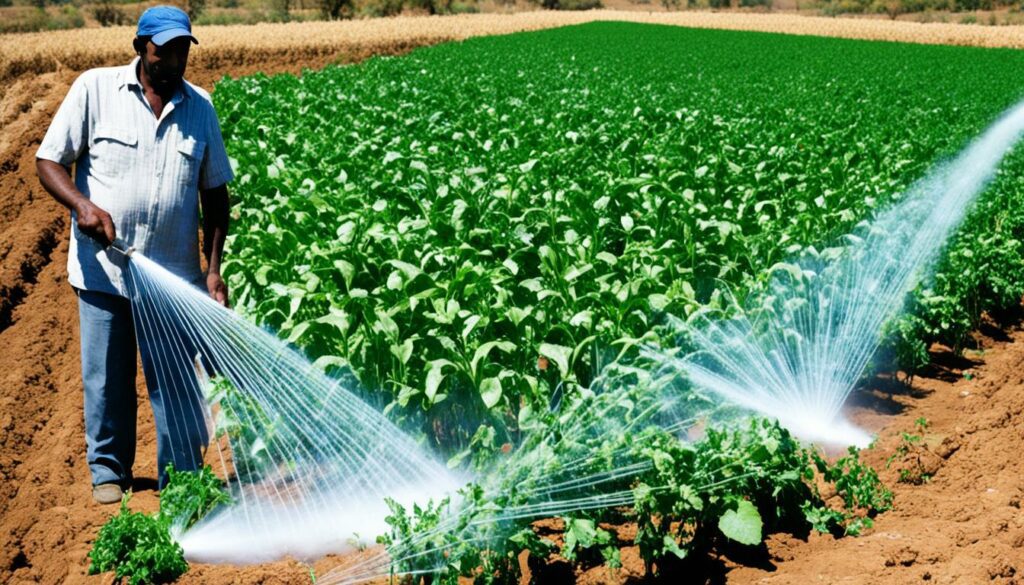
There are new precision agtech solutions helping to tackle these challenges. The TETHYS AQUA system, for one, uses images from satellites to offer precise advice. It costs a bit over 1 euro per day, which is affordable. Systems like this are making it easier for farmers to embrace new technology.
Many new products and technologies are being developed. There are over 200 research articles and 17 new precision irrigation products from U.S. universities. Additionally, 19 commercial products have been launched. All these show that agriculture is moving towards using more technology. More than 25 patents for irrigation scheduling also suggest we can expect simpler and more available tech in the future.
| Challenges | Solutions |
|---|---|
| Technological Complexity | Training and Education Programs |
| High Initial Costs | Cost-Effective Technologies like TETHYS AQUA |
| Resource Management | Advanced Sensor Networks and AI |
As technology adoption in agriculture grows, so will resource efficiency and better crop yields. This growth proves that investing in precision irrigation is vital. It’s not just an option for farming; it’s a key for sustainable and successful farms.
In the future, precision irrigation will change a lot. New technologies like the Internet of Things (IoT), self-driving machines, and better Variable Rate Technology (VRT) will make a big difference. This means we can manage water and resources better, leading to agriculture that is more sustainable and efficient.
The tech used in precision irrigation is always getting better. Thanks to IoT, we can gather and analyse data in real time very accurately. Now, soil and crop sensors update us constantly on things like nutrients and moisture. This helps us time our watering just right and avoid wasting water. Also, machines like drones and robots are making watering fields much more precise.
Smart farming is getting more and more data focused. As we innovate in agriculture, we can use better sensors and algorithms to plan ahead with our water usage. This will help us use resources in the best way. Big data will be key to these improvements, helping farmers make smarter choices by analysing lots of information.
Building the future of precision irrigation needs teams of tech experts, agronomists, and farmers to work together. This team effort will create solutions that any farm can use. By working across fields, we can make sure more farmers benefit from precision irrigation, boosting how sustainable and productive agriculture is.
To start with precision irrigation, you need to look closely at your field’s conditions. This means checking the soil, what your crops need, and your specific farm requirements. You’ll then pick the best irrigation technology, like drip or sprinkler systems. You might even choose advanced options with smart sensors and remote controls.
Precision irrigation gets water and nutrients right to the plants, when and where they need it. It does this in small, careful amounts. This way, it makes sure water and other resources are used well. And it helps crops grow as much as possible. A key part is fertigation, which puts fertilisers and water together for the plants at the perfect times.
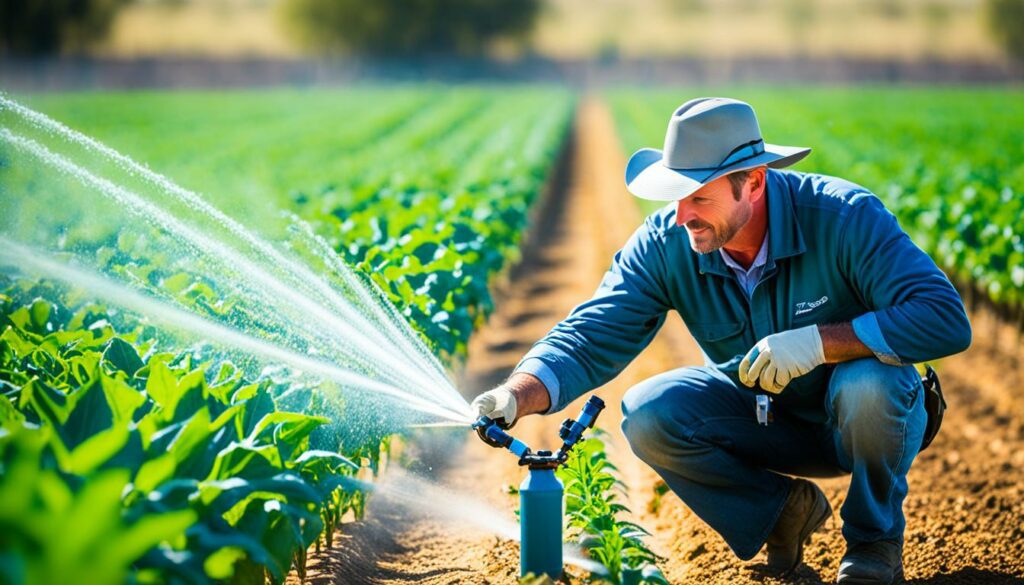
It’s important to check if using precision irrigation makes good economic sense. These systems usually pay for themselves in about three years, because they are very good at saving water. They are much better than other methods at not wasting water. This not only saves money on water but also on fertilisers and the people working to care for the crops. Plus, it helps the environment by reducing waste.
Talking to people who know a lot about this, like experienced sellers, or attending educational seminars, can help a lot. Lots of companies and experts are eager to help farmers move to smart irrigation. They make the change easier and make sure your investment really helps your farm.
Precision irrigation is especially important as we look to the future’s food needs. By 2050, the world will need to produce much more food. Precision irrigation is a smart way to grow more food without using a lot more resources. It can work on different types of land and handle water of various qualities. This makes it suitable for many different farming situations.
In finishing up our talk about precision irrigation, it’s clear this method fits well with sustainable farming. It helps manage water in agriculture effectively. By using less water and spreading it precisely, we save water and help businesses and nature. This is a big step in how we do farming.
Systems such as surface, sprinkler, and drip irrigation have done very well in growing more crops. Drip irrigation, for example, sends water directly to plants slowly, using less water and stopping weeds. Variable Rate Irrigation (VRI) is another smart method that waters certain spots as needed, making farming more efficient and producing better yields. These methods help use less water but grow more food.
New tools like the Normalised Difference Moisture Index (NDMI) and soil moisture data from satellites give farmers a better way to know when to water. They use weather predictions and past weather information to make farm watering smarter. With precision irrigation, studies have found we can save up to 40% of water compared to old ways. It’s very important in making farming more sustainable and in saving important resources. These new ideas help us balance growing more crops with protecting nature. They are key for a strong future in farming.
Precision irrigation is a new way to manage water in farming. It gives plants only the water they need, using smart tools and sensors. This approach helps farms use water more efficiently and saves water.
It’s important because it helps grow more crops with less water and fewer chemicals. This supports the environment by reducing pollution and tackling challenges like climate change. It also improves how farmers manage water, which is essential for the future.
Irrigation has come a long way thanks to new technology. Today, we have systems that water with great precision, including smart tools and sensors. These can detect when plants need water and adjust automatically.
The biggest benefits are water saving and higher crop yields. It also cuts down on labour and helps soils stay healthy. By giving plants just the right Water and nutrients, there’s less waste and pollution.
Systems can vary and include those like centre pivot models. They use different droplet sizes and pressures to water plants effectively. Many of these systems can be controlled by smart tech for the best results.
These systems have tubes, emitters, and valves for controlling water flow. They work at a low pressure, putting water right at the plants’ roots. This way, water doesn’t just evaporate into the air.
This type of irrigation puts Water directly under the soil, next to roots. This lessens water loss to the air and is great for drier places. It keeps plants consistently hydrated while saving water.
Soil sensors are crucial for knowing when and how much to water plants. They tell farmers exactly what the soil needs for best growth. This means crops get just the right amount of water, avoiding both waste and dry spells.
Companies like Netafim have advanced drip irrigation, making it highly efficient. CropX Technologies and Arable Labs offer smart tools for tracking soil health and water use, supporting precision farming.
Remote control lets farmers adjust water use from anywhere. This means they can respond quickly to changing conditions. It also helps save time and reduce the need to be constantly on site.
Data from all these sensors and tools help farmers make very accurate decisions. They allow for smarter, on-the-spot changes to watering plans. This fine-tuning is key to using water wisely.
It helps the planet by cutting down on both water waste and pollution. By using high-tech and clever planning, farming can be kinder to the environment. This way, natural resources are protected for the future.
Getting started can be expensive and require learning new skills. But, the industry is working hard to make these tools easier and cheaper to get. Keeping up with tech changes is also a challenge for some people.
The future is very high-tech, with more machines working without humans. It will use very detailed data to improve how water is used. This will let more farms benefit from smart watering and help protect the planet.
Starting with precision irrigation means looking at your field and picking the right tools. There are many technologies, so it’s good to research and talk to experts. They can help with the best advice and solutions.